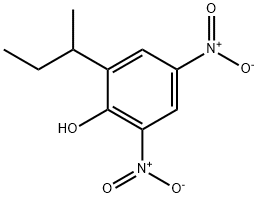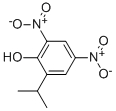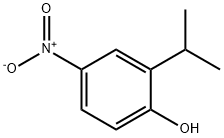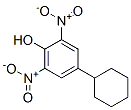2-CYCLOHEXYL-4,6-DINITROPHENOL
- CAS NO.:131-89-5
- Empirical Formula: C12H14N2O5
- Molecular Weight: 266.25
- MDL number: MFCD00242897
- EINECS: 205-042-5
- SAFETY DATA SHEET (SDS)
- Update Date: 2023-05-15 10:44:00

What is 2-CYCLOHEXYL-4,6-DINITROPHENOL?
The Uses of 2-CYCLOHEXYL-4,6-DINITROPHENOL
2-Cyclohexyl-4,6-dinitrophenol is a phenolic pollutant found in an environmental waste water.
Definition
ChEBI: Dinex is a ring assembly and an alkylbenzene.
General Description
Yellow crystals.
Reactivity Profile
Reacts with oxidizing materials and combustibles [USCG, 1999]. Special Hazards of Combustion Products: Can detonate or explode when heated under confinement [USCG, 1999]. Aromatic nitro compounds, such as 2-CYCLOHEXYL-4,6-DINITROPHENOL, range from slight to strong oxidizing agents. If mixed with reducing agents, including hydrides, sulfides and nitrides, they may begin a vigorous reaction that culminates in a detonation. The aromatic nitro compounds may explode in the presence of a base such as sodium hydroxide or potassium hydroxide even in the presence of water or organic solvents. The explosive tendencies of aromatic nitro compounds are increased by the presence of multiple nitro groups. Phenols do not behave as organic alcohols, as one might guess from the presence of a hydroxyl (-OH) group in their structure. Instead, they react as weak organic acids. Phenols and cresols are much weaker as acids than common carboxylic acids (phenol has Ka = 1.3 x 10^[-10]). These materials are incompatible with strong reducing substances such as hydrides, nitrides, alkali metals, and sulfides. Flammable gas (H2) is often generated, and the heat of the reaction may ignite the gas. Heat is also generated by the acid-base reaction between phenols and bases.
Health Hazard
Liver damage, metabolic stimulant, dermatitis, dilation of pupils.
Fire Hazard
Special Hazards of Combustion Products: Can detonate or explode when heated under confinement.
Trade name
DN®; DN-111®; DN dry mix; MIX No. 1®; DN dust No. 12®; DOW SPRAY®-17; DRY MIX No. 1®; PEDINEX®; SN 46®
Properties of 2-CYCLOHEXYL-4,6-DINITROPHENOL
| Melting point: | 106°C |
| Boiling point: | 409.45°C (rough estimate) |
| Density | 1.2846 (rough estimate) |
| refractive index | 1.6660 (estimate) |
| solubility | Chloroform (Slightly), DMSO (Slightly), Ethyl Acetate (Slightly) |
| pka | 4.08±0.38(Predicted) |
| form | Solid |
| color | Pale Yellow to Yellow |
| Water Solubility | 15mg/L(25 ºC) |
| EPA Substance Registry System | Dinex (131-89-5) |
Safety information for 2-CYCLOHEXYL-4,6-DINITROPHENOL
Computed Descriptors for 2-CYCLOHEXYL-4,6-DINITROPHENOL
New Products
4-AMINO-TETRAHYDRO-PYRAN-4-CARBOXYLIC ACID HCL 4-(Dimethylamino)tetrahydro-2H-pyran-4-carbonitrile 4-Aminotetrahydropyran-4-carbonitrile Hydrochloride (R)-3-Aminobutanenitrile Hydrochloride 3-((Dimethylamino)methyl)-5-methylhexan-2-one oxalate 1,4-Dioxa-8-azaspiro[4.5]decane 5-Bromo-2-nitropyridine Nimesulide BP Aceclofenac IP/BP/EP Diclofenac Sodium IP/BP/EP/USP Mefenamic Acid IP/BP/EP/USP Ornidazole IP Diclofenac Potassium THOMAIND PAPER PH 2.0 TO 4.5 1 BOX BUFFER CAPSULE PH 9.2 - 10 CAP SODIUM CHLORIDE 0.1N CVS ALLOXAN MONOHYDRATE 98% PLATINUM 0.5% ON 3 MM ALUMINA PELLETS (TYPE 73) LITHIUM AAS SOLUTION 2-Bromo-1-(bromomethyl)-3-chloro-5-nitrobenzene 2-Bromo-3-nitroaniline N-(3-Hydroxypropyl)-N-methylacetamide 3-Bromo-6-chloropyridazine 4-ethyl-3-nitrobenzoic acidRelated products of tetrahydrofuran








You may like
-
 1-Methyl-6-oxo-1,6-dihydropyridazine-3-carbonitrile 98%View Details
1-Methyl-6-oxo-1,6-dihydropyridazine-3-carbonitrile 98%View Details
99903-60-3 -
 88491-46-7 98%View Details
88491-46-7 98%View Details
88491-46-7 -
 1823368-42-8 98%View Details
1823368-42-8 98%View Details
1823368-42-8 -
 2-(3-(tert-butyl)phenoxy)-2-methylpropanoic acid 1307449-08-6 98%View Details
2-(3-(tert-butyl)phenoxy)-2-methylpropanoic acid 1307449-08-6 98%View Details
1307449-08-6 -
 Ethyl 3-(furan-2-yl)-3-hydroxypropanoate 25408-95-1 98%View Details
Ethyl 3-(furan-2-yl)-3-hydroxypropanoate 25408-95-1 98%View Details
25408-95-1 -
 2-Chloro-5-fluoro-1-methoxy-3-methylbenzene 98%View Details
2-Chloro-5-fluoro-1-methoxy-3-methylbenzene 98%View Details
1805639-70-6 -
 1784294-80-9 98%View Details
1784294-80-9 98%View Details
1784294-80-9 -
 Lithium ClavulanateView Details
Lithium ClavulanateView Details
61177-44-4